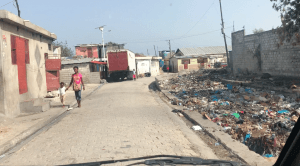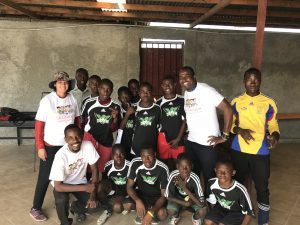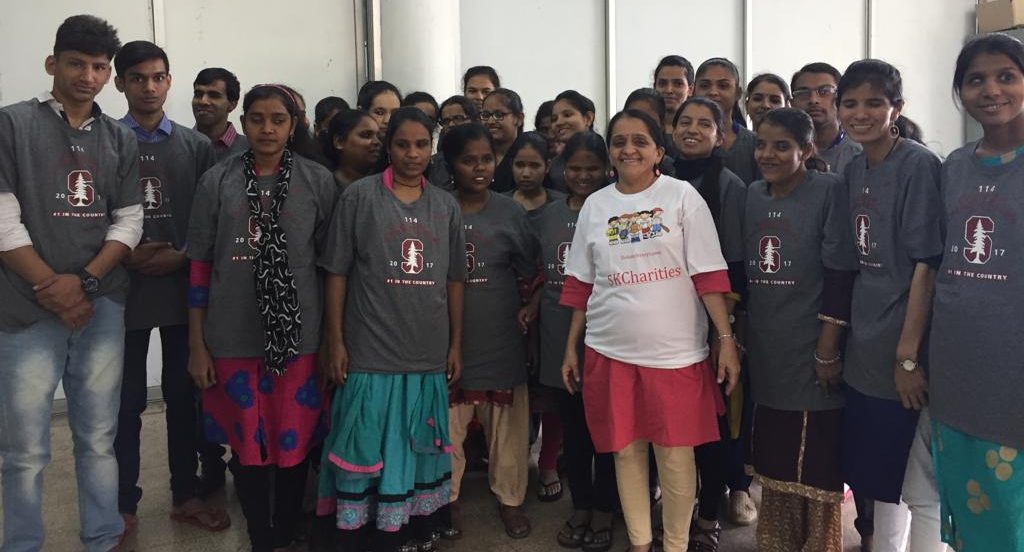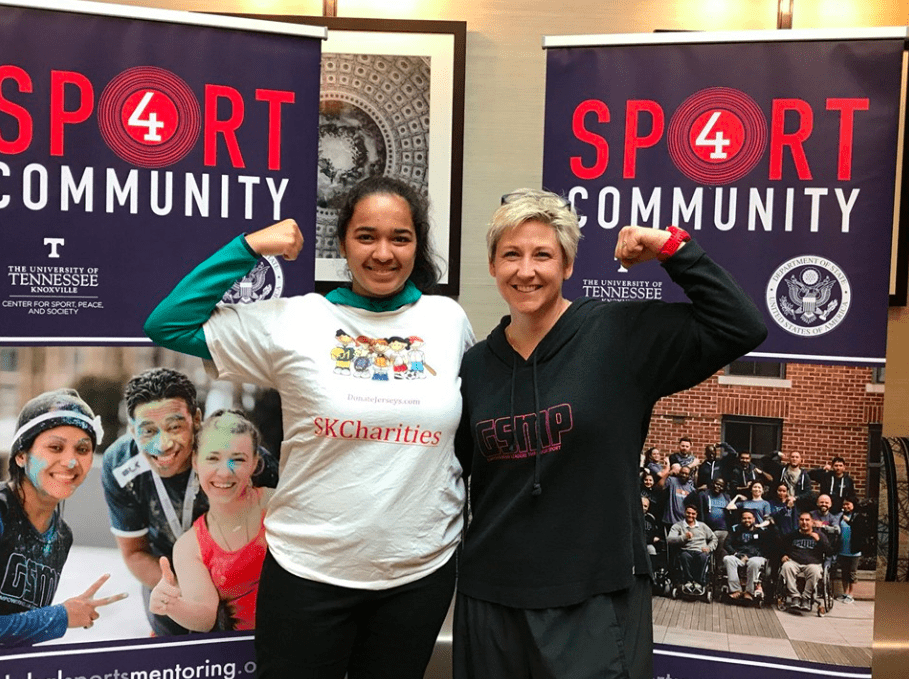I always have been passionate about sports and played both soccer and basketball since 2nd grade, but because of a concussion in 8th grade, I was unable to participate in any sport for over 15 months. This situation was extremely frustrating and I tried everything to get another chance to play again. During this time, I began to think about others who are unable to play because of financial issues and how despite being a good and passionate player, the costs for the gear needed for the sport is too much. The amount of money needed to participate in an organized sports team is a deterrent to many players from underprivileged communities. Being aware of this, I founded a 501(c)(3) state and federally approved non-profit, SKCharities, to help underprivileged children.
SKCharities collects used team jerseys from various club teams, universities, and players and donates them to the underprivileged children in our
society, giving them a chance to play the sport they love. Many children in poor countries are either forced to play in torn or old clothing, are not capable of paying the fees for the team, or cannot afford to play in general. To help families and players, SKCharities collects used athletic gear from various donors and donates it to the marginalized communities allowing children to have self-esteem, joy, and determination while playing the sport they love.
 During the summer of 2018, I met an individual who volunteered at a community center in Cité Soleil, Haiti every year called SAKALA. I immediately latched onto this information and the individual led me to Daniel Tillias, the founder of the community center SAKALA { http://www.sakala-haiti.org}. Daniel and I stayed in touch throughout the summer and planned out the soccer tournament that would take place on August 5th at SAKALA. On July 6th we sent out the jerseys, socks, soccer balls, and shoes to Haiti as the cargo shipment would take about three weeks to deliver the boxes. The gear we donated came from Evergreen Community College, San Jose State University, the University of St. Thomas Houston, and Santa Clara University.
During the summer of 2018, I met an individual who volunteered at a community center in Cité Soleil, Haiti every year called SAKALA. I immediately latched onto this information and the individual led me to Daniel Tillias, the founder of the community center SAKALA { http://www.sakala-haiti.org}. Daniel and I stayed in touch throughout the summer and planned out the soccer tournament that would take place on August 5th at SAKALA. On July 6th we sent out the jerseys, socks, soccer balls, and shoes to Haiti as the cargo shipment would take about three weeks to deliver the boxes. The gear we donated came from Evergreen Community College, San Jose State University, the University of St. Thomas Houston, and Santa Clara University.
On August 5th at 8 am I landed in Haiti. I soon met Daniel and he was ecstatic to meet me.

Daniel arrived in his worn down car and picked me up and we headed towards SAKALA. While in the car, the road was bumpy, I was constantly bouncing up and down and side to side as every few minutes we encountered deep potholes on the road. I examined the environment in Haiti and still vividly remember the worn-down city. Not only did Haiti have roads that resembled the roads from the war-torn country of Syria, but there were also no sidewalks, stop lights or stop signs. People walked and drove nonchalantly and did not bother to be careful. In addition to this, all the stores we passed by were run down and in deep need for repair. There were billboards covered in dirt and slum houses running alongside the roads. People sat on the other side of the road attempting to sell their trinkets in hope of earning some money to help improve their situation.

Seeing how these people lived was depressing and definitely surreal to me. People in the United States live very privileged lives and have order and luxury while countries like Haiti are barely surviving. Daniel explained how the country was still recovering from the earthquake that destroyed Haiti almost a decade ago. People wore torn clothes and were both skinnier and smaller than I was despite being years older than me. It was shameful riding in a car where I was protected and healthy while millions of people were outside suffering. I felt desperate to help, clean up their environment and move the residents into better homes than their current state of living. But the worst part of the city was yet to come.

We traveled along the road for a while when we arrived in Cité Soleil, one of the poorest parts of the country. Daniel took a right on a very narrow street that was about 6 ft wide with a wall on the left and a sewer FILLED with trash on the right. Daniel explained how the overflow of the sewer caused by the rains had collected

plastic and now resembled a plastic landfill. And right next to the sewer, people lived and walked past it as if it was a normal occurrence.
We took a couple more turns and followed the path of the sewer and soon arrived at SAKALA. When we arrived, we were surrounded with people prying the green gates to open. Someone kindly opened the gate for us and we entered the community center.
At a first glimpse, I thought there were only a few people present and concluded that the games had not started yet. However, when emerged into the community center, I saw the humongous crowd of people lining the sidelines of the soccer court. Two teams were in the middle of an intense game while the other five teams we sponsored were all sitting anxiously and dreading the wait time before their game. While exiting the car, Daniel continuously thanked me for the jerseys and explained how the jerseys helped the players feel more pride and excitement while playing. He further explained how the jerseys had changed the mindset and dynamics of the game as all the players began playing as a team rather than a one-man show. Cité Soleil is the poorest city in Haiti and every time players would represent SAKALA at a tournament, other teams would not take SAKALA seriously as they never look like an organized sports team. However, now that the teams have the jerseys, Daniel explained how they looked more competitive and teams would look at them as worthy.

When walking out of the car, I was stunned at the exceptional work Daniel had done to set up the center. Although the center was small, Daniel managed to fit almost everything in that space. One way he did this was by combining the soccer court, basketball court, and track into one area in the center. The cafeteria, classrooms, and bathrooms were all lined up around the bottom and right walls of the center. On the left side, there was a decorated wall separating the center from SAKALA’s garden.
Throughout the day, the heat increased, but the intensity of the games never decreased. The players and spectators were equally submerged into the games and celebrated greatly when a goal was made. While watching the games, I met a few girl students at SAKALA. There were about 10 of them that ranged from 18-22 years old and all were in their terminal year (12th grade). It was very rare for women in Haiti to be getting an education, but these girls broke the stereotypes and chose to pursue their dreams of becoming lawyers, doctors, and engineers. These girls followed an untraditional path and they were proud of what they were accomplishing. I enjoyed talking with the girls even though we had a hard time communicating with my minimal knowledge of French and their minimal knowledge of English. It turned out that they were volleyball players and would love some gear too.


The day passed and I visited the cafeteria where they were making food for all the players. The small cafeteria staff with a stove outside was preparing food for all the players to eat after the tournament finished. After visiting the cafeteria, I walked to the garden which was amazing. Daniel explained the accomplishments of the garden including being endorsed by the government and one of the largest gardens in Haiti in addition to showing me the type of food that is grown there. The garden’s base was made from a landfill and the garden currently uses tires and other large plastic or rubber objects to grow plants in. In addition to the plants, the center hopes to get domesticated animals and to raise cattle.
After the tour of the garden, we returned to watching the games. While watching, one of the players asked me to go to his little warehouse. Unaware of what he wanted, I followed him there The warehouse was 3 ft wide and 5 ft long enclosed by a fence that separated it from the outside. There were two boys and a small girl inside the warehouse that were working on making a bracelet that I found out they were making for me and my parents despite my mother not being there. I noticed the extreme focus and care the boys and girl were in while making a bracelet. Daniel later explained how the players desperately wanted to learn how to make bracelets and he and Daniel sat and watched Youtube videos to learn how to make the bracelets.

The games continued and the audience became more and more interested in the games as the finals were approaching. Everybody was desperate to win the tournament and take home the medals. Every time a goal was scored, the players jumped in excitement and the crowd roared. Soon the final game came and about halfway into the game a team scored. The crowd was jumping, the coach flew around the court with his hands flailing in the air and screaming with joy while the opposite team fought each other out of frustration. The game ended with the score of 1-0.

After the congratulations and celebration at the end of the game, everybody huddled around the metals that stood on the table, drooling while looking at them. Daniel said a few words then asked me to speak. Although I spoke in English, Daniel was able to translate for me and everybody thanked me for both the jerseys and organizing the tournament. We then handed out the medals to the winning team and to the coaches and the players smiled enthusiastically with pride and joy.
 After handing out the medals, Daniel brought out the soccer socks that I also donated to the program. Everybody swarmed the box and the first people in the box grabbed 10 pairs and walked away with groups players following him and each pleading for a pair. We donated enough for everybody, but the players snatched more socks wanting everything for themselves and leaving others with nothing. The fights were so intense that my father and I had to back away from the area and stand and watch. It was eye-opening to see all the players fighting over the soccer socks. Despite being pink in color, the boys relentlessly fought each other to get one pair. In the Bay Area, something as small as socks was considered a prerequisite and expected piece of equipment, but in Haiti, it was considered a privilege. At the end of the fights, everybody was satisfied with what they got and we quickly took a picture of the players. The teams then began to disassemble and the players headed home. I left soon thereafter with Daniel.
After handing out the medals, Daniel brought out the soccer socks that I also donated to the program. Everybody swarmed the box and the first people in the box grabbed 10 pairs and walked away with groups players following him and each pleading for a pair. We donated enough for everybody, but the players snatched more socks wanting everything for themselves and leaving others with nothing. The fights were so intense that my father and I had to back away from the area and stand and watch. It was eye-opening to see all the players fighting over the soccer socks. Despite being pink in color, the boys relentlessly fought each other to get one pair. In the Bay Area, something as small as socks was considered a prerequisite and expected piece of equipment, but in Haiti, it was considered a privilege. At the end of the fights, everybody was satisfied with what they got and we quickly took a picture of the players. The teams then began to disassemble and the players headed home. I left soon thereafter with Daniel.
The trip was amazing and I am continuing to do everything possible to provide more jerseys to the children in Haiti. This is just one example of the difference that donating jerseys can make. SAKALA is still looking for more equipment, so if you have anything to donate, please contact me at shevali@donatejerseys.com.
Thanks to the following Universities/Colleges that donated to SKCharities! The gear helped change many players’ lives in Haiti!
- The University of St. Thomas, Houston
- Evergreen Valley Community College
- San Jose State University
- Santa Clara University


